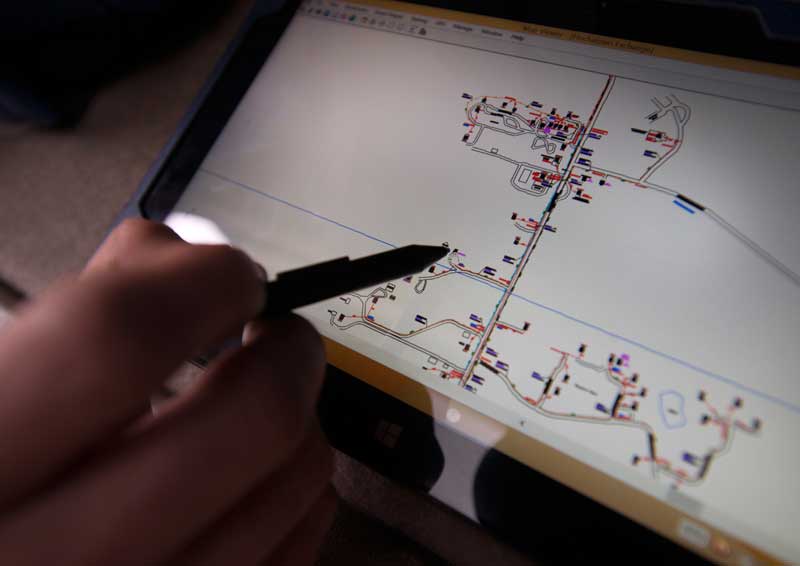Digital communications and infrastructure dependencies
Contents |
[edit] Introduction
The UK currently has one of the most advanced digital communication infrastructure systems in Europe. Considerable investment made early on has driven the UK’s strong e-commerce position. And recent UK policy developments – investment in 5G research and development, superfast broadband deployment, the recently launched Digital Strategy – indicate that the government is keen to build on this position and enable better connectivity for people and businesses.
This increasingly ubiquitous digital connectivity cannot be looked at without considering the technological changes this enables and the impacts on the existing physical infrastructure.
The increasing pervasiveness of digital and ‘smart’ technology, enabling collection and analysis of big data, is to have a profound impact on infrastructure needs, demands and delivery across all sectors – and is only likely to increase with future innovation.
5G technology has the potential to realise or enable a number of high-value use-cases, including autonomous vehicles, Internet of Things, smart cities, and real-time infrastructure operational data. However, consideration should be given to the impacts on other exiting infrastructure, like transport systems and particularly electricity generation.
[edit] 5G ambitions
Precisely what 5G is, and what it will do versus existing generations of connectivity, is as yet undefined.
Currently, it is anticipated that 5G technology will mean seamless connectivity, ultra-fast and ultra-reliable, transmitting massive amounts of data with virtually no lag. By 2050, it is expected that the main access points to data services will be through mobile devices and the internet of things based on widespread coverage of 5G, or other mobile broadband.
To date, there has been strong political ambition for the UK to be a world leader in 5G technology deployment, reflected in Ofcom Strategic Review of Digital Communications 2016 and the NIC Connected Future report.
However, the desire for expediency in delivery must be balanced with the need to ensure implementation of a system that can meet long-term economic, social and environmental needs. As with existing digital connectivity efforts must be made to ensure comprehensive coverage. This will require increased densification of supporting infrastructure, and changes to planning frameworks should be made with this in mind.
[edit] Infrastructure interdependencies
The ICE-led National Needs Assessment (NNA) highlighted the importance of considering infrastructure interdependencies between sectors as part of the NIA, and as infrastructure becomes increasingly ‘smart’ it can be expected that these interdependencies will deepen.
For example, digitally enabled infrastructure, ‘always on’ connectivity, and the rise of big data have considerable electricity generation and transmission implications.
The National Resource Defence Council reports that in 2013 US data centres consumed energy equivalent to 34 500MW coal fired power stations, managing the storage and sharing of the huge quantities of data requires policy action if data demand and ultimately energy to support are not to grow beyond sustainable levels.
This places considerable pressure upon existing generation and transmission infrastructure, particularly in the context of the growing electrification of transport and heat. However, smart electricity infrastructure can help to balance demand with new electricity generation coming onto the grid, enabling integration of renewables and electricity storage.
This article was originally published here by ICE on 13 March 2017. It was written by Kelly Forbes, ICE Policy Manager.
--The Institution of Civil Engineers
[edit] Related articles on Designing Buildings Wiki
- Achieving sustainable roads funding in England.
- Articles by ICE on Designing Buildings Wiki.
- Critical infrastructure is more vulnerable than ever. It doesn’t have to be that way.
- Designing smart cities.
- Digital Connectivity Infrastructure Accelerator DCIA.
- Digital transformation - engineers need to keep pace.
- Digital transformation - overcoming barriers.
- Electrotechnical industry gears up for All-IP switch.
- Engineering resilience to human threats.
- Email overload.
- Future skills for civil engineers.
- Infrastructure and cyber attacks.
- Intelligent building management systems IBMS.
- Internet of things.
- Smart buildings.
- State of the nation: Digital transformation.
- UK BIM Alliance and CIOB join forces.
- Vital infrastructure and redevelopment.
- WiFi.
Featured articles and news
The UK's Modern Industrial Strategy: A 10 year plan
Previous consultation criticism, current key elements and general support with some persisting reservations.
Building Safety Regulator reforms
New roles, new staff and a new fast track service pave the way for a single construction regulator.
Architectural Technologist CPDs and Communications
CIAT CPD… and how you can do it!
Cooling centres and cool spaces
Managing extreme heat in cities by directing the public to places for heat stress relief and water sources.
Winter gardens: A brief history and warm variations
Extending the season with glass in different forms and terms.
Restoring Great Yarmouth's Winter Gardens
Transforming one of the least sustainable constructions imaginable.
Construction Skills Mission Board launch sector drive
Newly formed government and industry collaboration set strategy for recruiting an additional 100,000 construction workers a year.
New Architects Code comes into effect in September 2025
ARB Architects Code of Conduct and Practice available with ongoing consultation regarding guidance.
Welsh Skills Body (Medr) launches ambitious plan
The new skills body brings together funding and regulation of tertiary education and research for the devolved nation.
Paul Gandy FCIOB announced as next CIOB President
Former Tilbury Douglas CEO takes helm.
UK Infrastructure: A 10 Year Strategy. In brief with reactions
With the National Infrastructure and Service Transformation Authority (NISTA).
Ebenezer Howard: inventor of the garden city. Book review.
The Grenfell Tower fire, eight years on
A time to pause and reflect as Dubai tower block fire reported just before anniversary.
Airtightness Topic Guide BSRIA TG 27/2025
Explaining the basics of airtightness, what it is, why it's important, when it's required and how it's carried out.
Construction contract awards hit lowest point of 2025
Plummeting for second consecutive month, intensifying concerns for housing and infrastructure goals.
Understanding Mental Health in the Built Environment 2025
Examining the state of mental health in construction, shedding light on levels of stress, anxiety and depression.























